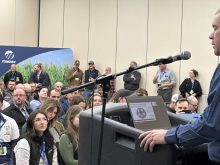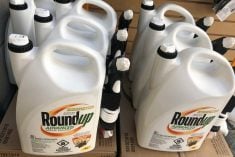Tillage and not wind or water is the biggest source of soil loss on farmers’ fields. David Lobb, a soil scientist at the University of Manitoba, says for decades people mistakenly thought the eroded knolls or hilltops in fields were caused mostly by wind.
“What causes the severe soil loss on hilltops is tillage erosion, the progressive movement of soil downslope through tillage,” he says, adding it has been shown that tillage erosion causes more of this severe topsoil loss on farms than water and wind erosion combined.
Read Also

Claas brings 1000 Series SP forage harvesters to Canada
In mid-August, Claas unveiled its new line of Jaguar forage harvesters at an event in Visalia, California, deep in the heart of that state’s dairy region.
Lobb likens tillage to pushing a road grader around the field — you’re scraping topsoil off the higher areas and dumping it in the lower areas. Essentially, that means over time no soil on the top of the hill and excess topsoil at the bottom.
“That’s the typical pattern of soil erosion across Canada, the Prairies, or otherwise, across North America, pretty much every place in the world where farmers are tilling soil,” he says.
According to Lobb, the most severe form of tillage erosion in Canada occurs on hummocky landscapes, which are abundant in the Prairie pothole region. You’ll find it too in areas underlain with undulating glacial till that form rolling hills, and “you can also see evidence of it in the so-called flat Red River Valley,” he says.
Lobb acknowledges conservation tillage practices like zero till have led to a big reduction in soil erosion losses generally on Canadian farms — but he stresses you can’t assume it’s stopped altogether.
“People believe that by soil conservation tillage, soil will be restored, but it won’t. It just slows the erosion, it slows the degradation, it doesn’t stop it,” he says.
Lobb worked closely with an organization called the Manitoba Zero Tillage Research Association for several years, and he points out one of the first things farmers asked him was “We’ve been doing this for years — why haven’t my yields got any better on the hilltops?”
Lobb says it’s because zero till and other conservation tillage practices don’t do anything to actually restore soil health on severely eroded knolls and hilltops. “The only way you’re going to build up organic matter productivity is to get more biomass into the soil.”
On top of that, he adds, with some seeders associated with high-disturbance zero till, there’s still some soil degradation going on in eroded areas.
Lobb contends a large, high-disturbance seeder travelling very fast can cause as much soil erosion as a moldboard plow — it moves less soil, but it moves it much farther and with much greater variability, which causes the soil loss. He says newer tillage techniques such as vertical tillage can also cause soil loss.
Which begs the question, what can farmers do about tillage erosion when they’re working their fields?
The obvious answer is to reduce tillage, Lobb says. “Reducing tillage is extremely important. You don’t want to do any tillage that isn’t necessary.”
Lobb says when it comes to primary tillage, a chisel plow will disturb less soil and leave more crop residue on the surface than a moldboard plow. While that helps prevent wind and water erosion, it actually increases tillage erosion, according to Lobb. That’s because a chisel plow will displace just as much soil and move it greater distances and with greater differences between the movement upslope and downslope.
Cutting down on secondary tillage by doing fewer passes with a disc and cultivators helps reduce tillage, wind and water erosion, Lobb notes.
If you’re still doing some form of tillage on your farm, Lobb says the key is “you don’t till too deep, no deeper than you have to, and you don’t till any faster than you have to.”
He maintains it is important farmers try to keep a constant pace when operating tillage equipment, since both high and variable speeds contribute to soil movement. Because equipment tends to move downhill faster than uphill, it means more soil is going down than up.
No-till or zero-till systems are generally viewed as the best prevention against tillage, wind and water erosion — a big reason why the practice is so prevalent on Prairie farms today.
However, it’s important to recognize tillage erosion can still occur with zero till, Lobb says. While high-disturbance seeding implements may not disrupt as much soil as tillage, the variability in how far the soil is moved can be great, especially at high speeds on hilly land, he adds.
A better option for reducing tillage erosion is low-disturbance seeding, “which is essentially a knife or a single disc putting seed in the slot. You have very little disturbance that way,” Lobb says.
“There’s no silver bullet in any of these things. You’re always going to have soil movement when you’re putting in any type of product into the soil,” he says. “It’s just a question of being aware that you’re potentially going to cause tillage erosion and doing whatever you can to minimize the tillage erosion that’s going to occur when you’re doing this operation.”
Think strategically
Marla Riekman is a soil management specialist with Manitoba Agriculture and Resource Development. Part of her job is providing extension services that educate farmers about best management practices related to soil health.
Riekman agrees some seeders, especially those used early on in the adoption of zero till, can be quite disruptive in terms of soil movement, but she believes it’s becoming less of a problem.
“Some seeders now that are more commonly used, like disc drills, are lower disturbance,” she says. “With a low-disturbance seeder, you have a little less erosivity.”
If they can, Riekman advises farmers to think strategically about how they can reduce tillage erosion; for example, by changing things up in their cropping systems and their use of tillage and seeding implements so the same piece of equipment isn’t always being used on the same field every year.
Riekman believes an important starting point is residue management, and that starts at the back of the combine.
“You want to make sure that your combine is ready, your straw chopper knives are sharp, your chaff spreader, everything is ready to go and is performing optimally as you’re getting ready for harvest. What that does is it sets you up for less problems later,” she says.
“If you can get proper chopping and sizing of your residue and a good spread of it, you may need less tillage passes later on, because you don’t have areas of heavy straw packs that you have to even out.”















